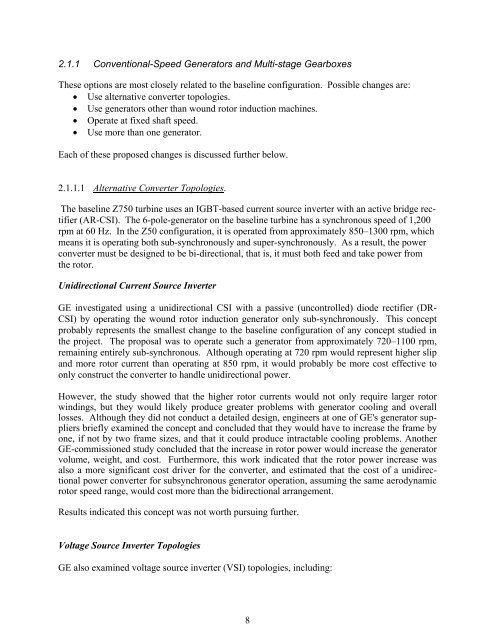Advanced Wind Turbine Program Next Generation Turbine ... - NREL
Advanced Wind Turbine Program Next Generation Turbine ... - NREL
Advanced Wind Turbine Program Next Generation Turbine ... - NREL
Create successful ePaper yourself
Turn your PDF publications into a flip-book with our unique Google optimized e-Paper software.
2.1.1 Conventional-Speed Generators and Multi-stage Gearboxes<br />
These options are most closely related to the baseline configuration. Possible changes are:<br />
• Use alternative converter topologies.<br />
• Use generators other than wound rotor induction machines.<br />
• Operate at fixed shaft speed.<br />
• Use more than one generator.<br />
Each of these proposed changes is discussed further below.<br />
2.1.1.1 Alternative Converter Topologies.<br />
The baseline Z750 turbine uses an IGBT-based current source inverter with an active bridge rectifier<br />
(AR-CSI). The 6-pole-generator on the baseline turbine has a synchronous speed of 1,200<br />
rpm at 60 Hz. In the Z50 configuration, it is operated from approximately 850–1300 rpm, which<br />
means it is operating both sub-synchronously and super-synchronously. As a result, the power<br />
converter must be designed to be bi-directional, that is, it must both feed and take power from<br />
the rotor.<br />
Unidirectional Current Source Inverter<br />
GE investigated using a unidirectional CSI with a passive (uncontrolled) diode rectifier (DR<br />
CSI) by operating the wound rotor induction generator only sub-synchronously. This concept<br />
probably represents the smallest change to the baseline configuration of any concept studied in<br />
the project. The proposal was to operate such a generator from approximately 720–1100 rpm,<br />
remaining entirely sub-synchronous. Although operating at 720 rpm would represent higher slip<br />
and more rotor current than operating at 850 rpm, it would probably be more cost effective to<br />
only construct the converter to handle unidirectional power.<br />
However, the study showed that the higher rotor currents would not only require larger rotor<br />
windings, but they would likely produce greater problems with generator cooling and overall<br />
losses. Although they did not conduct a detailed design, engineers at one of GE's generator suppliers<br />
briefly examined the concept and concluded that they would have to increase the frame by<br />
one, if not by two frame sizes, and that it could produce intractable cooling problems. Another<br />
GE-commissioned study concluded that the increase in rotor power would increase the generator<br />
volume, weight, and cost. Furthermore, this work indicated that the rotor power increase was<br />
also a more significant cost driver for the converter, and estimated that the cost of a unidirectional<br />
power converter for subsynchronous generator operation, assuming the same aerodynamic<br />
rotor speed range, would cost more than the bidirectional arrangement.<br />
Results indicated this concept was not worth pursuing further.<br />
Voltage Source Inverter Topologies<br />
GE also examined voltage source inverter (VSI) topologies, including:<br />
8
















